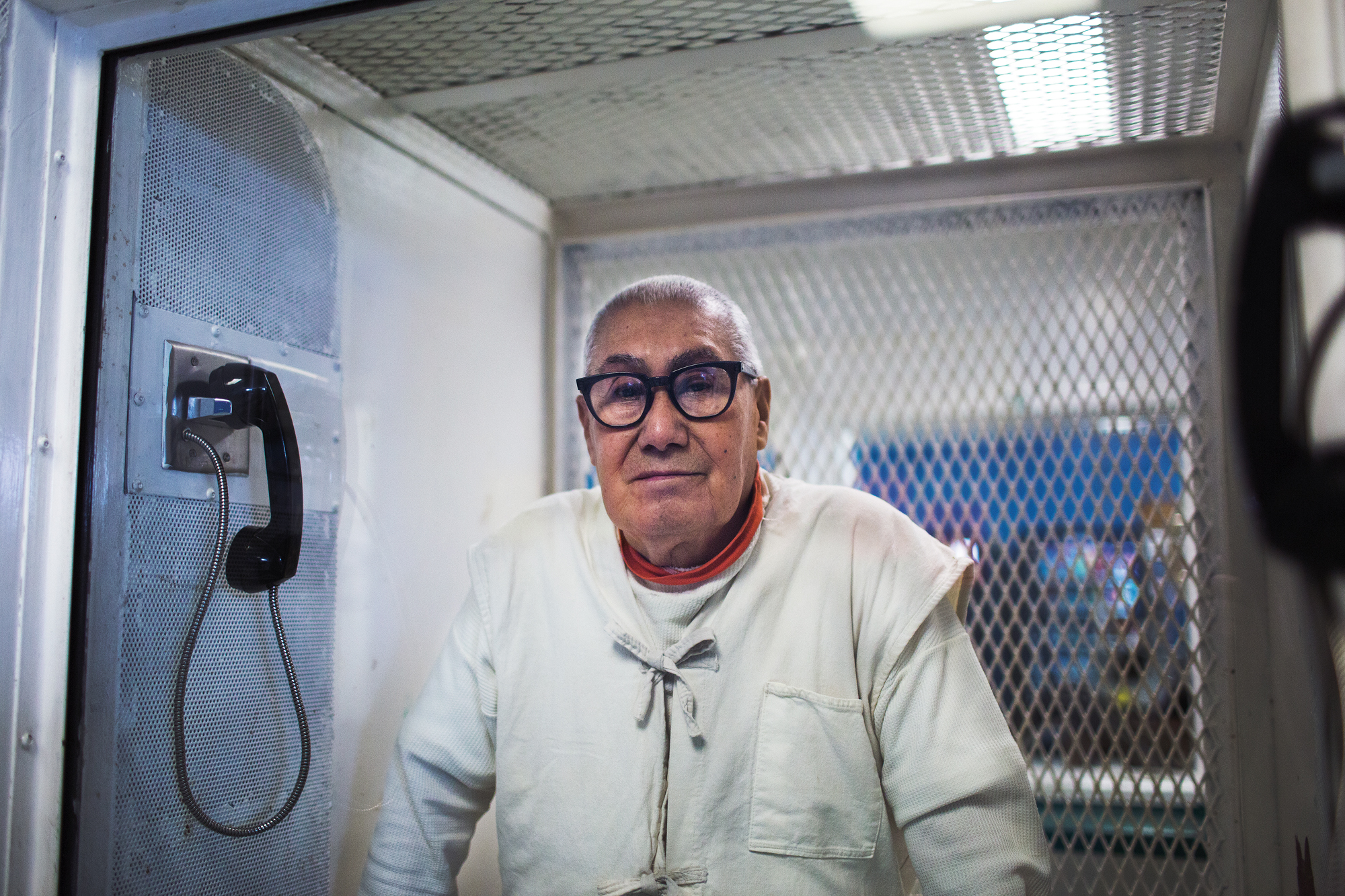
No Place for Old Men
Texas prisons are filling up with the old and the ill — at enormous expense.
A version of this story ran in the February 2016 issue.
Above: Benito Alonzo, 80, is an inmate at the Polunsky Unit. He suffers from prostate cancer and Hepatitis C.
Benito Alonzo is a short, 140-pound 80-year-old. His quiet-spoken manner, drooping jowls and gray hair, trimmed in a buzz, give him the appearance of a benevolent grandfather, and indeed, he is a grandfather. In thick-framed black eyeglasses, he bears a resemblance to the defanged and aging Henry Kissinger. But Alonzo is neither a celebrity nor a statesman. He’s a convict who has lately grown infirm.
He says he’s been diagnosed with prostate cancer and he’s afflicted with Hepatitis C. For several years he’s been prescribed a drug called Lactulose, which Dr. Owen Murray, chief of medical affairs for the Texas penal system, says “we use for people whose livers are at the end of their lives.” In November, the University of Texas Medical Branch in Galveston told Alonzo’s son in a letter that during a recent medical examination, it also found “evidence of cirrhosis,” an often-fatal ailment.
I talked to Alonzo in December in the waiting room of the Polunsky Unit, near Livingston. That was not the way I wanted to see him: I had wanted to visit his cell, his pod, to observe how he passes his time — to see how he lives. But the Texas Department of Criminal Justice (TDCJ) doesn’t allow reporters beyond its visiting rooms, and it forbids taking pictures inside the prisons. For a year I corresponded with Alonzo and a dozen other elderly inmates, querying them about their circumstances. Mail was the only connection we had. When I asked Alonzo, in Spanish, if he thought prison authorities could monitor our conversation in that language, he chuckled and said, “And in Japanese, Arabic or Russian.” We conducted the rest of our chat in English.
Alonzo has been waiting since at least March for the start of a 12-week course of a new liver drug that might keep him alive for years to come. He’s been told that the treatment will cost $94,500. Were he back on the streets, Medicare would pick up the tab. But because federal courts have ruled that states must guarantee the safety and health of their inmates, Texas will have to pay. Alonzo frets that because of the expense, prison bureaucrats will stall the treatment until it’s too late.
The state of Texas operates 109 prisons holding about 148,000 inmates. Some 27,000 of them are, like Alonzo, over the age of 50. They account for about 18 percent of the prison population, and are the fastest-growing demographic group among prisoners. By most estimates, they are also the most expensive to keep under lock and key. According to TDCJ spokesman Robert Hurst, the average cost of housing Texas inmates is about $20,000 a year, but medical and end-of-life expenses hike that figure to some $30,000 for elderly inmates. In other jurisdictions, the cost is even higher. A 2012 report from the ACLU calculates the average national expense for keeping a prisoner at $34,000 per year — and twice that much, $68,000, for inmates older than 50.
Both demographic factors and get-tough sentencing have transformed what were once mere penal institutions into hospitals, assisted living centers and nursing homes, too. The University of Texas Medical Branch operates a freestanding hospital in Galveston for TDCJ, which also contracts with UTMB and the Texas Tech medical school to send prisoners to 146 community hospitals. Texas prisons now boast of “respiratory isolation rooms,” “brace and limb services” and hospice facilities in which 90 Texas inmates were eased into eternity last year. More than 300 inmates in Texas prisons use wheelchairs, Dr. Murray says.
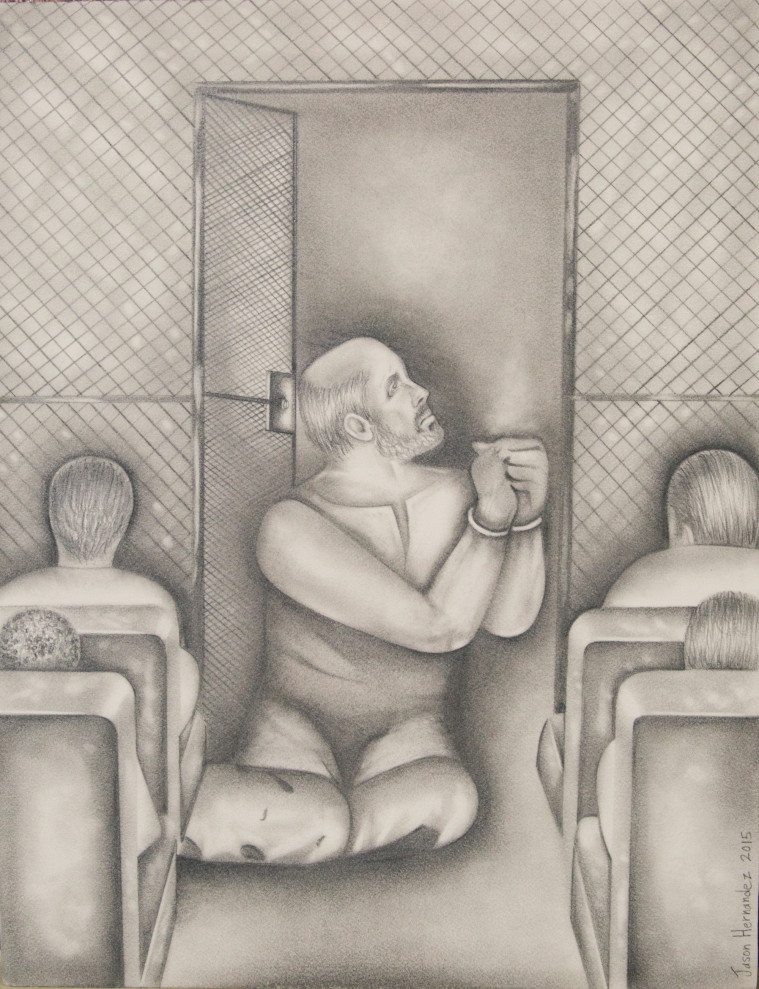
Alonzo’s life has been one of alternating spans of heroin addiction and confinement. He served three separate stints in prison — for theft, burglary and heroin possession — from 1958 to 1974. After his parole in 1974, allegedly under the influence of two of his brothers, Pedro and Adolfo, he delivered a pair of pistols to a warden’s trustee who then smuggled them into Huntsville’s Walls Unit. San Antonio gangster Fred Carrasco used those guns in an 11-day hostage-taking and stand-off that culminated in a shootout. Alonzo is serving a life sentence for his connection to the incident.
He is not a humorless guy, and when I told him that he is the oldest convict among 5,500 men in “administrative segregation,” as TDCJ terms solitary confinement, he seemed amused. Men in solitary are generally allowed a one-hour break each weekday in fenced, bathroom-sized outdoor courtyards. Alonzo spends his exercise time “walking around in circles — like a psych patient,” he says with a grin.
He’s been in solitary since 1985 because he is what the prison system terms a “confirmed member” of a “Security Threat Group,” in this case, the Mexican Mafia. His calm and good cheer may also be informed by a macho, gangland code. While thousands of convicts say that they are innocent of the charges that brought them to prison, guys like Alonzo don’t whine. Doing so would violate the Mafia’s code of manliness and spoil his image, which among convicts, is that of a respected elder.
But a younger “ad seg” prisoner, Jason J. Hernandez, a 42-year-old with a string of convictions for theft, sometimes complains on his behalf. Hernandez gripes, for example, that when ad seg prisoners are shackled for trips to medical facilities, their hands are also clapped into handcuffs and into a device known as a “black box.” Black boxes make it difficult to raise one’s hands and arms. Their purpose is to prevent assaults upon guards or fellow prisoners. But the upshot, Hernandez charges, is that prisoners whose mobility is limited cannot use handrails to get on or off of the “chain” buses that transport them. They must hop or crawl instead, and for elders, hopping poses a danger of falling. Alonzo must sometimes take more than one bus to travel for medical care to Galveston. (A TDCJ spokesperson said correctional officers assist elderly inmates getting on and off buses.)
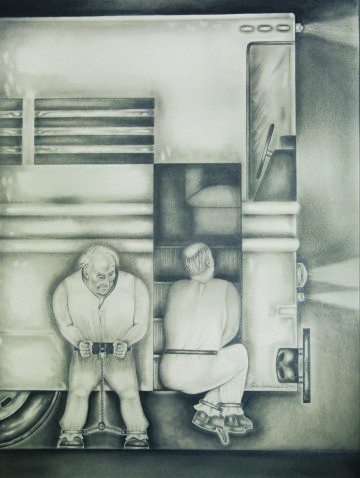
In one of the letters that Hernandez wrote me, he relays a story from “a senior,” probably Alonzo:
“He then told me that on one trip, an overweight man … was struggling into the chain bus. … His pants began to fall down to his knees. The prisoner asked the chain guards to please help him pull up his pants so that he wouldn’t trip, because he’d just underwent surgery on his knees and couldn’t bend down. The guards said, ‘We’re not going to lift his pants up for him.’ The prisoner was stuck with his pants down in front of everyone.”
Hernandez also says that staff shortages and negligence frequently imperil seniors. Convicts in solitary are moved every two weeks to prevent conspiracies, and Hernandez claims that during one of these cell switches in April, he watched as two guards accompanied Alonzo, his hands cuffed tightly behind his back, to a 3-by-6-foot unventilated shower stall, one of a half-dozen located in a row one tier below Hernandez’s cell. The apparent plan of the guards was to leave Alonzo there for a few minutes while they made the change. But the cell-switching was prolonged for more than half an hour, and the memory of a notorious incident a decade before sent Alonzo into a panic.
In 2003, an inmate at the McConnell Unit in Beeville died after spending two hours in a shower stall. An autopsy showed that the McConnell prisoner had been soaked in 190-degree waters that literally cooked his internal organs. Alonzo was an inmate at McConnell when that happened. Even though he was still dressed and water wasn’t coming from the showerhead, Alonzo says that when the vaporous atmosphere of the shower-stall row made it hard for him to breathe, he “started hollering and banging.”
Prison spokesman Hurst says that TDCJ records don’t show that anything of the kind happened, but according to Hernandez, when nobody rushed to Alonzo’s aid he and inmates in neighboring cells began kicking their doors and hollering demands that the old man be taken out of the shower. Perhaps the guards, he says, were called to more pressing duties; the Texas prison system suffers from a shortage of some 3,500 correctional officers, and those on duty can’t always promptly attend to matters. Hernandez alleges that by the time they came to his door to quiet the din, “I [had] blanked out and was ready to fight the team with all my might as hard as I could. … I tried to push the issue. I began to yell at the guards, ‘What’s up, bitch? What’s up, you fucking pussies!’”
The racket and insults shook the guards to their senses, he says. Realizing that they’d forgotten about Alonzo, they promptly pulled him from the shower — and even apologized. They then moved him, for the next two weeks, into the cell next to Hernandez.
Though neither Hernandez nor Alonzo will say as much, Alonzo may be lucky because he’s in solitary confinement. Prisons are stocked with aggressive young men who aren’t called “offenders” for nothing. Old and infirm prisoners are generally too mellowed to be aggressive, but all too often, they are also incapable of defending themselves. While solitary has been shown to have deleterious effects on mental health, it does protect the weak from the strong, the prudent from the rowdy, and, presumably, the old from the young.
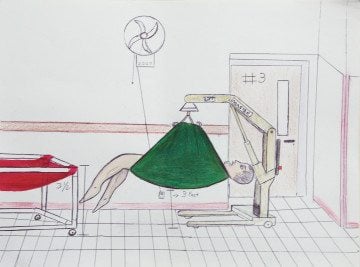
Years ago, the Texas Department of Corrections, as it was then called, segregated inmates strictly by race and more informally by age, but discrimination along both those lines fell in the wake of prison reforms. Today, TDCJ takes account of the dangers of aging largely by classifying inmates with mobility problems as eligible for assignment only to the lower bunks of its two-bunk cells. But the result, several elderly prisoners at the Michael Unit in East Texas wrote me, is a shortage of lower-level bunks — and some wind up “mishoused” in solitary confinement.
The state of Texas does have a process for releasing old and infirm prisoners on humanitarian parole, but the record is underwhelming. A bureaucracy dating to 1987, the Texas Correctional office on offenders with Medical or Mental Impairments, usually named by the clunky acronym TCOOMMI, was assigned to process medically recommended intensive supervision, or MRIS, paroles. MRIS is a way to move inmates rendered harmless by their frailty or age back into the civilian world.
TCOOMMI reports to the Texas Board of Pardons and Paroles on an inmate’s health status, leaving the final parole decision to the board. In a February 2015 biennial report, TCOOMMI reported that of the 1,133 MRIS applications that had been submitted in fiscal year 2014, 318 had been found sufficiently meritorious for presentation to the parole board. Of those, the board had granted 67 releases — a mere 6 percent approval rate.
In a 2012 statement, TDCJ admitted that “the Parole Board’s approval rates of MRIS cases remain low.” But the board’s performance hasn’t shown signs of improvement. In the 2015 fiscal year, 445 prisoners older than 60 filed for medical paroles — but only 24 paroles were granted, all of them on the basis of infirmity, none on the basis of age. The roadblock is a provision of the law allowing the parole board to conclude that a prisoner constitutes a threat despite what doctors say.
The last years of Johnny R. Martinez, aka Juan Ramírez Martinez, provide a case in point. Martinez, short of stature and a bit chubby, was a small-time Austin hoodlum. He’d done prison time from 1962 to 1965 for aggravated robbery, from 1966 to 1968 for forging a check, and from 1971 to 1986 for possession of heroin. Each sentence had ended with a grant of parole. But in 1993, at the age of 52, he returned to prison after conviction for touching the genitals of two minors, both 11 and the grandchildren of his live-in girlfriend, Phyllis Ketcham. Though testimony from one of the children and secondhand reports from the mothers of both were aired in court, Martinez and Ketcham hotly denied his guilt.
Martinez was a diabetic. Ketcham had complained early in his sentence about the boots TDCJ had issued him, saying that he was experiencing neuropathy, a common diabetic discomfort marked by numbness and/or pain in the soles of the feet. Around 2000, his vision began to fail, as it often does as diabetes advances.
Medical records provided to the Observer by Ketcham state that in 2002 he developed diabetic gangrene in his left foot and “was admitted on 07/25 to the hospital and taken to surgery that night for guillotine amputation of the foot.” The fix didn’t work. “The following Monday, 4 days later,” the records state, “he was revised to a below the knee amputation.” His medical records also note that by then, he was “legally blind.” Later that year, the parole board rejected his first application for MRIS parole. Perhaps a one-legged blind man in a wheelchair can sexually assault children — but what are the odds?
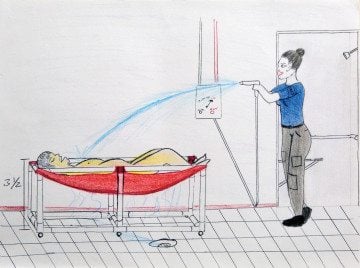
In 2007, prison doctors again recommended Martinez for MRIS parole, again without success. Late that year he was placed on dialysis three days a week for “End State Renal Disease.” An examination subsequently turned up cataracts and retinal detachment.
According to the medical records, on December 10, 2010, “when he was told by his fellow inmates that there is a blackened area that has developed over his right heel,” Martinez reported for hospitalization again. His medical caretakers found a “foul smelling foot” with “wet and dry gangrene.” Three days later, they amputated his right leg below the knee. At the time of discharge, Martinez, then 69, was being administered 16 oral medications and six insulin injections every day. His records show that he needed “total assist” with “dressing, toileting, and hygiene,” but they don’t indicate how much any of his care cost the state.
His declining health finally led to an MRIS parole — but not until June 2013, when he was taken to a private nursing home in Houston, blind, immobile and with a new limitation, mental confusion. He died in the nursing facility in September, thoroughly tortured, if not by imprisonment, then by his decade-long medical decline.
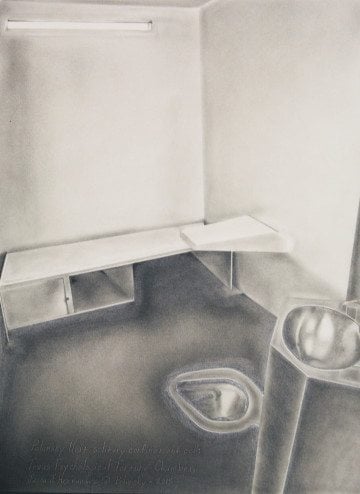
As both the statistics and cases like that of Martinez show, given the reluctant disposition of the parole board, Benito Alonzo, who is still sighted and still ambulatory, likely wouldn’t stand a chance of release under the beneficence of the MRIS program, even if he bothered to apply. He’s also eligible for parole of the ordinary kind — and has been for the past 31 years. He’s been denied parole 21 times, probably because his crime was notorious. Two women, both prison system employees, were killed along with Carrasco and a co-conspirator. Alonzo’s crime was against the people of Texas, according to legal theory, but it’s probably more important to his parole history that his was also a crime against TDCJ.
Benito Alonzo would today have a hard time exacting any revenge or harming anybody, and whether he lives or dies is of little concern except to a coterie of kin and perhaps in the circles of the Mexican Mafia. If he dies in prison, as we must currently expect, though he’d prefer to be interred in San Antonio, his corpse will be eligible for a casket and a grave at public expense, in the prison cemetery, of course.
[Featured image by Jen Reel. Benito Alonzo, 80, is an inmate at the Polunsky Unit. He suffers from prostate cancer and Hepatitis C.]


